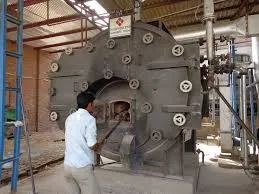
Dec . 03, 2024 10:42 Back to list
steam boiler installation guide
A Comprehensive Guide to Steam Boiler Installation
Installing a steam boiler is a critical task that requires careful planning, adherence to safety regulations, and a thorough understanding of the system’s components. Whether it is for a commercial facility or a residential property, proper installation ensures that the boiler operates efficiently and safely. This article outlines key steps and considerations for the installation of a steam boiler.
Understanding the Basics of Steam Boilers
Before diving into installation, it is essential to understand what a steam boiler is and how it functions. A steam boiler converts water into steam by using heat from burning fuel or electricity. This steam is then distributed throughout a building for heating purposes or used in industrial processes. There are various types of steam boilers, including fire-tube and water-tube models, each having its own operational mechanics and applications.
Pre-Installation Planning
1. Determine Your Requirements The first step in the installation process is assessing your steam needs. Calculate the steam load requirements based on factors such as building size, purpose, and peak demand times. This helps in selecting a boiler with the appropriate capacity and efficiency.
2. Choose the Right Location The installation location should be accessible, well-ventilated, and compliant with local building codes. Considerations should include proximity to fuel sources, drainage for condensate, and enough space for maintenance and repair access.
3. Regulatory Compliance Ensure that you comply with local codes and regulations regarding safety and environmental standards. It may be necessary to obtain permits before installation.
Equipment and Material Selection
Selecting the right boiler is crucial for efficiency and lifespan. Consider factors such as fuel type (natural gas, oil, or electric), desired efficiency ratings, and brand reputation. Ensure that all auxiliary equipment, including pumps, valves, and controls, meets the required specifications and standards.
The Installation Process
steam boiler installation guide

1. Foundation and Base Preparation Construct a solid and level foundation for the boiler. This can be a concrete slab or reinforced structure that can support the weight of the boiler and associated equipment.
2. Piping Installation Install steam and return lines according to the design specifications. Use high-quality, insulated piping to minimize heat loss. Ensure proper sizing to facilitate appropriate steam flow and prevent operational issues.
3. Setting Up the Boiler Carefully position the boiler on the prepared foundation. Connect it to fuel supply (if applicable), water feed lines, and electrical supply. Ensure all connections are watertight and secure.
4. Safety Features Install necessary safety devices, including pressure relief valves, low-water cutoffs, and water level indicators. These are essential to prevent mishaps and ensure safe operation.
5. System Start-Up Once the installation is complete, conduct a thorough inspection. Check all valves, gauges, and controls. Begin filling the boiler with water and purging air from the system. Start the boiler and monitor its operation closely for any irregularities.
Post-Installation
1. Testing and Commissioning After initial operation, perform a series of tests to confirm the system operates correctly. Check for steam leaks, pressure stability, and gauge accuracy.
2. Maintenance Schedule Establish a regular maintenance program to ensure the boiler operates efficiently and safely throughout its lifespan. This includes periodic inspections, cleaning, and necessary repairs.
3. Operator Training Ensure that personnel responsible for operating the boiler are adequately trained on its operation, safety features, and emergency procedures. This helps minimize the risks associated with boiler operation.
Conclusion
The installation of a steam boiler is a thoughtful process that combines technical expertise with attention to safety. By following this guide, you can set the foundation for a successful and efficient boiler installation. Always remember to consult with qualified professionals and adhere to local regulations to ensure the system's optimal operation and longevity. A well-installed steam boiler not only improves heating efficiency but also enhances the overall safety and functionality of the property it serves.
-
High-Efficiency Commercial Oil Fired Steam Boiler for Industry
NewsJul.30,2025
-
High-Efficiency Biomass Fired Thermal Oil Boiler Solutions
NewsJul.30,2025
-
High Efficiency Gas Fired Thermal Oil Boiler for Industrial Heating
NewsJul.29,2025
-
High-Efficiency Gas Fired Hot Water Boiler for Sale – Reliable & Affordable
NewsJul.29,2025
-
High Efficiency Biomass Fired Hot Water Boiler for Industrial and Commercial Use
NewsJul.29,2025
-
High-Efficiency Biomass Fired Hot Water Boiler for Industrial Use
NewsJul.28,2025
Related PRODUCTS






















